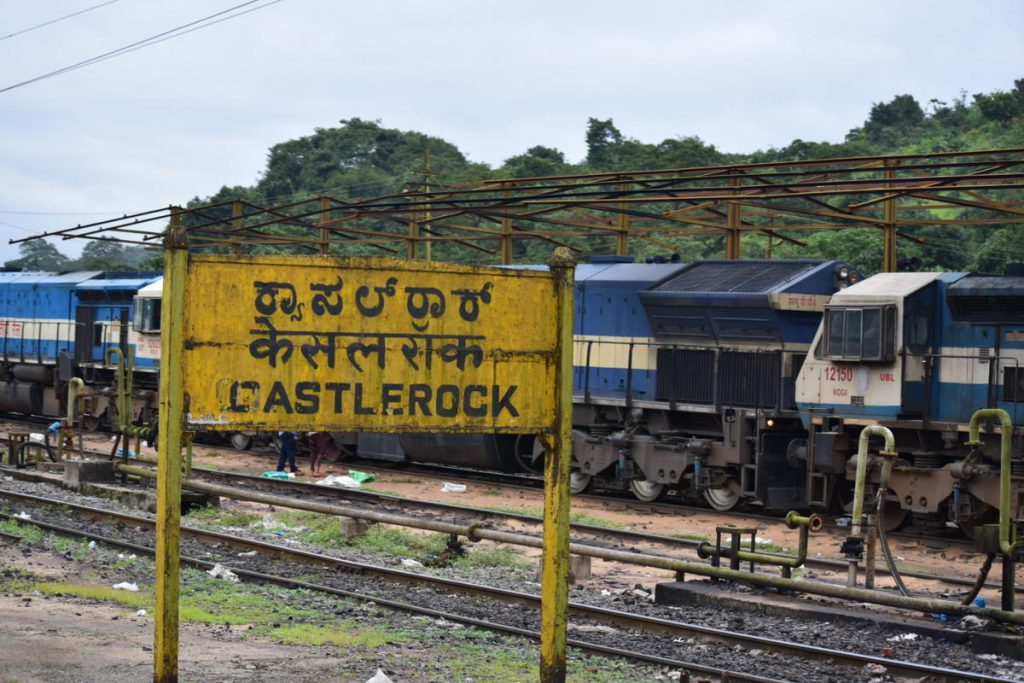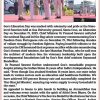Goa is abuzz with excitement as vintage bike and car owners, users, collectors and fans are decking […]

SC STOPS DOUBLE- TRACKING OF SWR IN GOA
In the News, May 14 -20 May 2022 May 13, 2022HALTED: The Supreme Court has halted the double-tracking of the stretch of South Western Railway from Castlerock to Kulem
The Supreme Court has upheld the objections of the Centrally-Empowered Committee on the double -tracking of the South Western Railway from Castlerock to Kulem, citing great damage to bio diversity and disruption of the tiger corridor. Excerpts from the observation from the report of the Centrally-Empowered Committee which have been endorsed by the Supreme Court.
The 25-page judgement which came on May 9, 2022 from Justice L Nageshwara Rao who presided over the bench led to jubilant celebrations in Goa with various environment groups welcoming the good news…
“12. We have heard Mr. A.D.N. Rao, learned Senior Counsel for the CEC, Mr. Prasant Bhushan, learned counsel for Goa Foundation, Mr. Sanjay Upadhyay, learned counsel for RVNL and Mr. Balbir Singh, learned counsel for Ministry of Railways.
Mr. Rao supported the report of the CEC and recommended the revocation of permission granted by NBWL to the doubling of railway line from Castlerock to Kulem for the following reasons:
a) The section capacity of entire route was not being fully utilized by the railways due to severe restrictions owing to the alignment and the gradient of the tough terrain. The capacity utilization was below 50% due to severe constraints in the Ghat Section.
b) In the proposed second line, there would be 23 tunnels which would fall outside the existing right of way and would tantamount to formation of a new line altogether.
c) Even according to RVNL, the traffic on Konkan Railway is frequently dislocated due to landslides, breaches etc. especially during the rainy season. Permitting construction of a second line between Kulem and Caslterock where the gradient is as high as 1:37 would only invite grave danger of a further disaster.
d) A third railway line from Toranagallu Junction to Krishnapattam Port would be a better alternative than construction of a second line connecting Murmagao Port to the industrial belt in Bellary district.
e) The disposal of muck deposit which is likely to be generated in huge quantities would pose a difficult challenge for the Railways and for which adequate arrangement has not been kept in place by RVNL.
f) The opinion of NTCA was not taken by the NBWL even when the Goa part of the project includes an important tiger reserve and where instances of killing of tigers have been recorded.
g) Preservation of biodiversity and conservation of the eco-system of the Western Ghats outweighs the need for doubling the railway line.
- On behalf of RVNL, the project proponent, it was submitted that the project is super critical and it was sanctioned in 2011-2012. Connectivity to Goa and the hinterlands was taken into account by the Ministry of Railways before the project was sanctioned. All statutory clearances have been obtained before undertaking the doubling of the railways line. Stage II clearance was granted by the Ministry of Environment and Climate Change on 12.04.2022 for undertaking doubling in the State of Karnataka and Goa.
It was further stated that the Bhagwan Mahaveer Wildlife Sanctuary has not been notified as a Tiger Reserve under the Wildlife Protection Act, 1972 and therefore there was no need for RVNL to approach the NTCA seeking a report for the Goa part of the Project. It was contended by RVNL that the CEC failed to take into account that observations of the NTCA pertained to Danderi Wildlife Sanctuary in the State of Karnataka and not with respect to the project falling within the State of Goa. The project proponent attempted to justify the project by contending that State-of-the-Art wildlife mitigation measures have been adopted by the project proponent, implementation of which is being monitored by the experts.
RVNL also brought to the notice of this Court a Comprehensive Biodiversity and environment assessment undertaken by the Indian Institute of Science, Bengaluru for Castlerock and Kulem stretch in August, 2017. It assured this Court that Rail over-bridges and Road under-bridges would be constructed for crossing of animals. This Court was further informed that there has not been a single instance of death of any major animal, including tiger, since 1890s on the railway track.
An assurance was given to this Court that there would be no additional disturbance to the forest area as no separate pathway would be constructed in the forest area for transportation of goods and machinery which would be carried out in the most ecologically efficient manner. Only such of those trees which are essential will be felled and compensatory afforestation would be taken up.
Permission was sought from NBWL for sanction of doubling of railway line from Castlerock to Kulem after examining all the other alternatives. RVNL contended that the material that was submitted was not taken into consideration by the CEC before recommending for revocation of the license granted by the NBWL for doubling of the railway line. - According to Mr. Bhushan, learned counsel for the Goa Foundation, the approval of NTCA is mandatory as per Section 38 (O)(g) of the Wildlife Protection Act, 1972. He submitted that Bhagwan Mahaveer Wildlife Sanctuary is an important tiger corridor which needs to be protected. The NTCA approval submitted for the State of Karnataka has to be considered and a cumulative study has to be taken up for protected species in Goa as well.
Goa Foundation apprehends that the doubling of railway line would increase the dangers of severe environmental degradation owing to massive cutting of trees which would then have an adverse impact on the climate and temperature of the protected area apart from habitat discontinuities, impact on species etc. The further complaint of Goa Foundation is that advice of Wildlife Institute of India was not obtained for Goa portion for doubling of railway line.
Goa Foundation alleged that the increase in the annual requirement of the coal and other raw material was not adequately demonstrated by RVNL. It stated that there is no basis for the contention of RVNL that it anticipates increase of container traffic on the line. Goa Foundation recommended acceptance of the report of CEC and revocation of the permission granted by the NBWL for doubling the railway line between Castlerock and Kulem. - Adherence to the principle of sustainable development is a constitutional requirement. While applying the principle of sustainable development one must bear in mind that development which meets the needs of the present without compromising the ability of the future generations to meet their own needs. Therefore, Courts are required to balance development needs with the protection of the environment and ecology.
It is the duty of the State under our Constitution to devise and implement a coherent and coordinated programme to meet its obligation of sustainable development based on inter-generational equity. While economic development should not be allowed to take place at the cost of ecology or by causing widespread environment destruction and violation; at the same time, the necessity to preserve ecology and environment should not hamper economic and other developments. Both development and environment must go hand in hand, in other words, there should not be development at the cost of environment and vice versa, but there should be development while taking due care and ensuring the protection of environment. - In Vellore Citizens’ Welfare Forum v. Union of India, this Court held that the ‘Precautionary Principle’ is an essential feature of the principle of ‘Sustainable Development’. It went on to explain the precautionary principle in the following terms: –
(i) Environmental measures — by the State Government and the statutory authorities — must anticipate, prevent and attack the causes of environmental degradation.
(ii) Where there are threats of serious and irreversible damage, lack of scientific certainty should not be used as a reason for postponing measures to prevent environmental degradation.
(iii) The “onus of proof” is on the actor or the developer/industrialist to show that his action is environmentally benign. - The principle of precaution involves the anticipation of environmental harm and taking measures to avoid it or to choose the least environmentally harmful activity. It is based on scientific uncertainty. Environmental protection should not only aim at protecting health, property and economic interest but also protect the environment for its own sake. Precautionary duties must not only be triggered by the suspicion of concrete danger but also by justified concern or risk potential.
- A situation may arise where there may be irreparable damage to the environment after an activity is allowed to go ahead and if it is stopped, there may be irreparable damage to economic interest. This Court held that in case of a doubt, protection of environment would have precedence over the economic interest. It was further held that precautionary principle requires anticipatory action to be taken to prevent harm and that harm can be prevented even on a reasonable suspicion. Further, this Court emphasises in the said judgment that it is not always necessary that there should be direct evidence of harm to the environment.
- Keeping in mind the aforesaid principle of law on sustainable development and precautionary principle, we proceed to examine whether the recommendation made by the CEC should be accepted. Doubling of the railway line between Castlerock to Kulem is a part of the critical project undertaken by the Ministry of Railways in the year 2011 in public interest. Whether the justification for doubling the railway line would outweigh the environmental concerns raised by the Goa Foundation which found favour with the CEC is the question that falls for determination. We are of the view that the CEC is right in its conclusion that the proposal for the doubling of the railway line between Castlerock to Kulem by NBWL should be revoked for the reasons as stated hereinafter.
- The Ministry of Railways or RVNL have failed to provide any substantial basis for the requirement of doubling the railway line by addressing the impact which it would have on the habitat and the damage that it would cause to the environment. RVNL attempted to justify its decision on the ground that there is a likelihood that the requirement of coal and other raw materials would be doubled in the future and the proposed project is very much essential for transportation of said goods. Reliance was placed by RVNL on a Parliamentary clarification dated 02.02.2022 and a letter of the Ministry of Power, Government of India to argue that there is no likelihood of shift from coal-based economy. We are in agreement with the CEC that the requirement of coal can be met by utilising the Krishnapatnam port which is a viable alternative for transportation of coal. The said suggestion would also prevent the degradation of the Western Ghats.
Even according to RVNL, traffic on Konkan railway line is frequently dislocated due to landslides, breaches, etc, especially during the rainy season. In view of the difficult terrain having sharp curves and gradient as high as 1:37 for the proposed project, any further construction would invite a great disaster in the sensitive areas of Western Ghats as well.”















